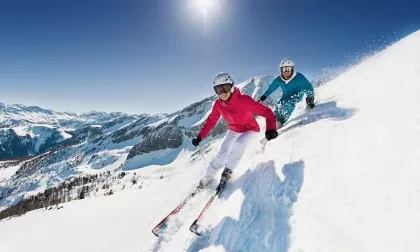Common Skiing and Snowboarding Injuries and Tips to Prevent Them

Changes in the snow conditions, fatigue, binding release failure, or falling in an awkward manner, can all cause twisting falls, or ligaments and tendons to tear and in the most severe circumstances the joint to dislocate and bones to break. To protect yourself this holiday/ski season, follow these simple tips.
Research published earlier in 2023 summarized interesting findings when it comes to ski and snowboarding injuries. According to the study, knee injury to the ligaments was the most frequent skiing injury, with ACL injuries accounting for 14.9% of the total injuries, while snowboarding was associated with a lower prevalence of such injuries, specifically 3.1%.
Fractures of the distal radius and ulna (wrist) constituted 31.4% of upper extremity injuries observed in snowboarding activities. The contact between the hands and the ground during a backward fall (i.e., heel side) is believed to be a crucial self-protective mechanism contributing significantly to wrist injuries.
Most injuries were caused by individual falls, not collisions and those with limited expertise were more likely to injury themselves.
Tips to prevent an Injury
Changes in the snow conditions, fatigue, binding release failure, or falling in an awkward manner, can all cause twisting falls, or ligaments and tendons to tear and in the most severe circumstances the joint to dislocate and bones to break. To protect yourself this holiday/ski season, follow these simple tips.
Train and Strengthen
No matter your age or fitness level, it is important to adequately prepare for a ski holiday. Check your local gym or fitness center for ski/snowboard specific programs that can help prepare you for the season. If getting ready at home try a regimen of stretching, squats, wall-sitting and side planks mixed with cardio to help you prepare.
Proper Technique and Posture for Skiing and Snowboarding
If you have never had a lesson, or it has been a while since you were out on the slopes, it is important you take time to learn the proper techniques for skiing and snowboarding. You want to make certain knees and ankles flex equally and your weight is distributed properly. Even an experienced skier or snowboarder could benefit from coaching lessons to help hone posture and technique. The best defense against injury is to always be using the proper form. Additionally, knowing how to loosen your body and draw in your limbs during a fall will also make you less likely to injure yourself.
Know Your Limits
Listen to your body. If you are feeling tired or “off” it is important to take a rest. Feeling stiff or anxious can also increase your chances of injury. Be certain to warm up and stretch before and after you hit the slopes, taking the right amount of relaxation between runs. Consuming alcohol also increases your chances of injury. Staying on marked trails helps lessen your chances of concealed obstacles like rocks or stumps.
Of course, if a skiing or snowboarding injury does occur the expert orthopedic specialists at Southern Oregon Orthopedics are here to help. If you have a non-emergent injury, call ahead, or walk in without an appointment for orthopedic treatment today.
Orthopedic Walk-In Clinic at Southern Oregon Orthopedics
2780 E Barnett Rd #200, Medford, OR 97504
Phone: (541) 779-6250
Source: https://www.ncbi.nlm.nih.gov/pmc/articles/PMC10464917/